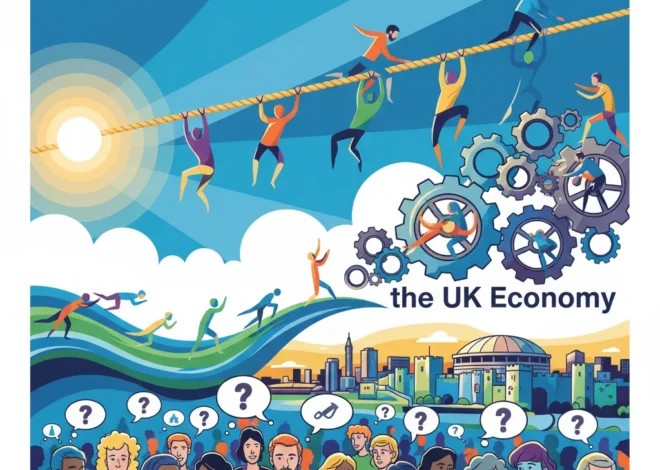
The Great British Tax Paradox: Decoding the Real Impact of the Latest UK Budget
Every government budget is a high-wire act, a delicate balancing of economic stimulus, fiscal responsibility, and political messaging. The latest UK Budget is no exception, presenting a narrative of tax cuts while the lived experience for many, as highlighted in a recent BBC News report, tells a more complicated story. While the headline announcement—a 2p cut in National Insurance—was designed to resonate with millions of workers, its effects are being blunted by a powerful, less-visible economic force: fiscal drag.
This article moves beyond the political soundbites to provide a comprehensive analysis for investors, finance professionals, and anyone seeking to understand the true state of the UK economy. We will dissect the key policy changes, explain the mechanics of fiscal drag, and explore the wider implications for personal finance, the stock market, and the future of British economic policy.
The Headline Giveaway: A Closer Look at the National Insurance Cut
The centerpiece of the Chancellor’s announcement was a further 2 percentage point reduction in the main rate of National Insurance (NI) for employees, bringing it down from 10% to 8%. A similar cut was announced for the self-employed. On the surface, this is a straightforward tax cut designed to increase the take-home pay for approximately 27 million workers and stimulate consumer spending.
But who really benefits, and by how much? To understand the direct impact, let’s break down the annual savings for different income levels.
The table below illustrates the estimated annual savings from the NI cut for employees, based on the reduction from 10% to 8% on earnings between the Primary Threshold (£12,570) and the Upper Earnings Limit (£50,270).
| Annual Salary | Estimated Annual NI Savings | Effective Monthly Increase |
|---|---|---|
| £20,000 | £148.60 | £12.38 |
| £35,000 | £448.60 | £37.38 |
| £50,270 | £754.00 | £62.83 |
| £70,000 | £754.00 (capped at UEL) | £62.83 |
While any increase in take-home pay is welcome, the data shows a clear limitation. The benefits are capped for higher earners, and notably, the policy offers no direct relief to pensioners or those who rely on income from investing, as NI is levied on earned income only. This targeted approach has significant consequences for household finance across different demographics.
The Stealth Tax: Why Many Will Still Pay More
The paradox at the heart of the budget—and the reason a person earning £20,000 might end up paying more tax, as the BBC article title suggests—is a phenomenon known as “fiscal drag.” This is arguably the most important concept for understanding the UK’s current tax landscape.
In simple terms, fiscal drag occurs when tax thresholds and allowances do not rise in line with inflation and wage growth. The UK government has frozen the personal income tax allowance and higher-rate threshold until 2028. Here’s how it works:
- Inflation and Wage Growth: As prices rise, employers often increase wages to help employees maintain their standard of living.
- Frozen Thresholds: The point at which you start paying income tax (£12,570) and the point at which you start paying the higher 40% rate (£50,270) remain fixed.
- The “Drag”: As wages rise, more of a worker’s income is “dragged” into a higher tax bracket, or for lower earners, dragged into paying tax for the first time.
The Office for Budget Responsibility (OBR), the UK’s independent fiscal watchdog, has projected that this freeze will create millions of new taxpayers and pull millions more into the higher rate band. For many, the additional income tax paid due to fiscal drag will partially or completely wipe out the savings from the National Insurance cut. This stealthy increase in the overall tax burden allows the government to raise revenue without announcing explicit tax hikes, but it creates significant pressure on household budgets.
The Ripple Effect: Broader Implications for the Economy and Investors
A national budget is more than a collection of tax policies; it’s a signal to the global financial markets. The decisions made have far-reaching consequences for the UK economy, the banking sector, and investment strategies.
From a macroeconomic perspective, the budget attempts to thread a needle. The tax cuts are intended to be expansionary, encouraging spending and boosting GDP. However, this runs the risk of being inflationary, potentially complicating the Bank of England’s mission to bring inflation back to its 2% target. The OBR’s analysis suggests the impact on inflation will be modest, but it’s a risk that currency and bond traders will be watching closely.
For the stock market, the reaction is nuanced. Sectors reliant on consumer spending may see a short-term lift. However, the overall picture is one of a heavily taxed economy still grappling with slow growth. International investors will be weighing the pre-election giveaways against the UK’s long-term fiscal sustainability. The country’s debt-to-GDP ratio remains high, and any policies perceived as fiscally irresponsible could weaken sterling and increase government borrowing costs.
The world of financial technology also plays a role. Modern fintech platforms and budgeting apps empower individuals to track their finances with greater precision. This increased transparency means households may become more acutely aware of the effects of fiscal drag, potentially influencing spending and saving behaviour more rapidly than in the past.
Bitcoin's Coiled Spring: Why a Major Price Move Is Imminent
A Fractured Landscape: How Different Groups Are Affected
The aggregate economic data often masks the profoundly different ways policies impact individuals. The BBC’s interviews provide a crucial ground-level view of this fractured landscape.
- Low-to-Middle Earners: This group, like the single parent earning £20,000, is caught in the crossfire. They receive a modest benefit from the NI cut but are highly susceptible to fiscal drag pushing them into paying more income tax over time.
- The Self-Employed: While they also received an NI cut, this group often faces greater financial volatility. For them, the budget’s failure to address issues like late payments or provide more robust support for entrepreneurship may be more significant than the tax tweak.
- High Earners and Families: A positive development for some families was the reform of the High Income Child Benefit Charge. Raising the threshold at which child benefit is withdrawn from £50,000 to £60,000 will provide relief to many, illustrating a more targeted approach to easing financial pressures on “squeezed middle” households.
The Future of Taxation in a Digital Economy
Looking ahead, this budget highlights a broader challenge facing advanced economies: how to tax effectively in the 21st century. The reliance on traditional payroll taxes like NI and income tax, combined with stealth measures like fiscal drag, may not be sustainable. As the nature of work evolves and digital assets become more prevalent, governments will need to innovate.
Discussions around the globe are already exploring new frontiers in public finance. This includes everything from digital services taxes aimed at tech giants to more speculative, long-term ideas about how technologies like blockchain could one day be used to create more transparent and efficient tax collection systems. While not part of this budget, these trends in global economics and trading form the backdrop against which future fiscal policy will be set. The ongoing challenge will be to create a tax system that is fair, efficient, and fit for the digital age.
Bitcoin at a Crossroads: Decoding the Signals for a Rebound or a Deeper Dive
Conclusion: A Budget of Calculated Compromises
The latest UK Budget is a document of calculated compromises. It offers a tangible tax cut to working people while simultaneously overseeing one of the largest stealth tax rises in recent history through fiscal drag. The result is an economic landscape that feels uncertain and, for many, unforgiving.
For individuals, the key takeaway is the critical importance of proactive financial planning. Understanding how both headline and hidden tax policies affect your specific situation is no longer a luxury but a necessity. For investors and business leaders, the budget serves as a reminder of the UK’s ongoing economic challenges. While there are pockets of relief, the broader narrative is one of a high-tax, low-growth environment that requires careful navigation. The true test of this budget will not be in the immediate headlines, but in its long-term impact on the prosperity of the very people it purports to help.


